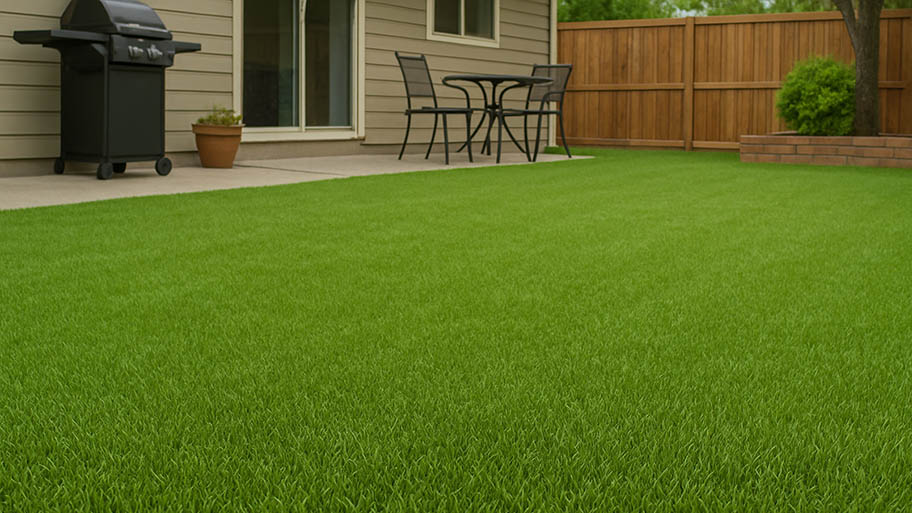
Artificial grass is a low-maintenance alternative to traditional turf. Learn how much artificial grass installation costs and what affects your price.
Create a fresh start for your lawn by starting with a blank slate
While hiring a pro to remove grass costs between $1 and $3 per square foot, they can effectively remove unwanted grass and ensure your lawn is ready for new turf.
DIY grass removal, including disposing of and reseeding or laying new sod, can take you hours to complete.
Lawn care pros have turf cutters that can drastically speed up the grass removal process.
If your goal is to have a healthy lawn, sometimes it’s necessary to remove existing grass and start anew. But, learning how to remove grass can be a tricky task without the help of a lawn care professional. Here are the top five ways to remove grass from your yard when you need to start from scratch.
Removing grass from your lawn requires effort, regardless of your chosen removal method. However, some methods are more labor-intensive than others, and with strategic planning, the project doesn't have to be technically hard. In general, faster methods require more physical labor or specialized equipment, while slower methods require less machinery and less intense labor.
The easiest way to remove grass depends on your circumstances. If you want to remove a small portion of your lawn to make room for a garden or other purpose that doesn't require eliminating the entire lawn, smothering and composting, using herbicides, or solarization are the easiest methods of killing the grass. However, despite being more labor-intensive, using a sod cutter combined with a shovel or two for small areas is the easiest and fastest way to remove large amounts of grass.
The necessary tools for removing grass vary depending on the removal method and the size of the area. A shovel may be all you need to remove small areas. You may need a turf cutter or sod cutter to remove an entire lawn or a large section of it. Other tools may include a garden tiller, herbicide sprayer, or a rake for moving mulch and other materials.
There are two basic ways to remove grass. The first requires physically removing it from the premises by mechanical means. The second method involves various ways of killing it and removing the leftovers if necessary. Using a sod cutter or shovel removes the grass while it's alive, while killing the grass involves smothering or solarizing it or using herbicides.
Planning how to remove your grass depends on how much you need to remove and how quickly you need to do it.
| Method | Speed | Area Size |
|---|---|---|
| Sod Cutter | 1–2 Days | Large |
| Shovel | 1–4 Days | Small |
| Herbicide | 7–30 Days | Large or Small |
| Smothering | 60–180 Days | Small to Medium |
| Solarization | 30–60 Days | Small to Medium |

Before pulling up your lawn, always double-check if your homeowners association or local municipal organizations regulate making major changes to your lawn. For example, chemical removal may be out of the question in some areas. Other areas may require special permits to mark your lawn for water and electrical lines before proceeding. With these factors in mind, consider the best option below.
Rent a walk-behind sod cutter from your local landscape or hardware store to avoid the difficult work of removing sod with a shovel. Sod cutters create an even slice several inches below your turf to remove the grass, roots, and the top layer of soil. This deep cut will keep grass and weeds from growing back, and it leaves an even layer of soil.
Mark large obstructions in your yard, such as sprinkler heads, buried rocks, large tree roots, and utility lines, and plan your sod-cutting route.
Put on safety gear, including eyewear, ear protection, gloves, and closed-toe or protective footwear.
Follow the machine's instructions to cut the sod.
Roll up and remove strips of cut turf.
Removing smaller grass areas is doable with a shovel, but it’s far more labor-intensive. The grading beneath your shoveled grass will not be as even as when using a sod cutter. It is also easier to miss persistent weed roots with this method. However, removing grass with a shovel is an option for small flower beds or when replacing a trouble spot in your lawn.
Mark out the area of lawn you wish to remove with marking paint or stakes.
Dig out the desired section and level off with a garden rake or equivalent tool.
Use a garden tiller to help break up the soil before or after digging the grass.
There's no question that a nonselective herbicide is the least labor and time-intensive way to remove grass, but it's not ideal in all situations. Some local municipalities do not allow the extensive use of herbicides, especially if your lawn is prone to runoff into local water systems.
If you’re removing grass with herbicides, wear protection over your eyes, ears, hands, and skin. You should also fence off the edge of your lawn before applying to keep people and pets from exploring the area.
Wear protective clothing, including safety goggles, a protective suit, gloves, and closed-toe footwear.
Apply the herbicide by carefully following the manufacturer's instructions for your chosen product.
Wait seven to 14 days and rake away the debris.
If you have bright, direct sunlight on your lawn—and between six and eight weeks to complete the process—solarization is a trustworthy way to remove grass, weeds, and pests without chemicals.
This grass-removal process requires you to cover your lawn with a thick, clear plastic sheet for six to eight weeks to kill off the grass and weeds underneath it, using heat from the sun.
You can use black or dark plastic as an alternative method that uses the ground's heat for a similar effect. Using dark plastic also kills the lawn by not allowing photosynthesis. This dark-plastic method is often more effective than using clear plastic in Northern regions that don't experience as much direct sunlight.
Roll out and securely stake the large plastic sheeting in place. Using heavy objects such as smooth stones or sandbags can hold it down without damaging the plastic.
Wait between four and eight weeks.
Remove the plastic and rake away the debris if necessary.
Sheet mulching is another chemical-free way to remove grass. Many people refer to the process as smothering and composting. Either way, the process breaks down any plants beneath a layer of newspaper or cardboard—known as a weed barrier—and mulch without damaging the soil. When executed correctly, the grass will decompose in four to six months.
Fully cover the grass you intend to remove with a single layer of newspapers or untreated and unwaxed cardboard.
Cover the material with a roughly 3-inch layer of compost containing leaves, grass clippings, and other yard waste.
Allow the setup to work for up to six months.
After you remove the grass from your desired area, remember to check the quality of your soil, look for the presence of remaining weed roots, and treat pests problems like grub infestations. A local landscaper can also help guide you through the recultivation process—whether you're starting fresh with new turf or hoping to give your lawn a new look. Common steps include one or several of the following tasks.
Test the soil and amend it with lime, compost, or other materials if necessary.
Repair the grading using tools, adding new soil, or eliminating unwanted amounts.
Treat for pests or lawn diseases if necessary.
Use grass seed or sod to replace the lawn.
Consider lawn alternatives like imitation grass, various landscaping ideas, or a rock garden.
While some grass-removal methods are possible to execute on your own, it’s best to hire a local lawn care professional to carry out this important job. The last thing you want is a torn-up or half-removed lawn, so hiring lawn care pros who can help you determine the best removal method based on your lawn and desired outcome is the right way to go. Plus, professional lawn removers will ensure high-quality results that will prepare your lawn for its next phase.
Deciding whether to treat or replace your lawn may also come down to cost. Major lawn maintenance costs include services like dethatching for $175 per hour, or reseeding a lawn for an average of $1,000 for the whole project. The average cost to resod a lawn is $1,850—so it depends on the size of your project and the extent of your lawn damage.
Removing the grass from your lawn may be a necessary—albeit major—step in several scenarios. Here are the top reasons to consider removing your lawn.
Many homeowners are starting to consider the benefits of xeriscaping—low-water and low-maintenance landscape designs. Additionally, non-grass lawn alternatives may be more attractive or require less frequent maintenance. You’ll need to remove your existing lawn design to install this type of lawn alternative.
Homeowners may also want to remove a small section of grass to plant a flower or vegetable garden. Properly removing turf ensures that the grass and weeds will not grow back and take over your tomato patch.
You may also need to remove grass from your lawn when you plan to replace it with new grass. There are a few common ways to ruin your lawn, leading to irreversible issues such as:
Untreatable grass disease
Pests problems like grubs
Weed takeover
Over-fertilized or burnt grass
Dry and dead grass
Choosing the wrong grass for your area
When a lawn becomes severely unhealthy, removing the grass and starting from scratch is often necessary. Since grass removal is both labor-intensive and costly, it’s worthwhile to put effort into maintaining a healthy lawn.
If your lawn has not yet reached the point of no return, consider implementing these lawn-saving strategies:
Test the pH and nutrient level of your soil
Use a fertilizer to correct any issues
Aerate and dethatch your lawn
Adopt a consistent mowing routine based on grass type and climate.
Water regularly and deeply, but avoid overwatering
Make sure your lawn has proper drainage channels
From average costs to expert advice, get all the answers you need to get your job done.

Artificial grass is a low-maintenance alternative to traditional turf. Learn how much artificial grass installation costs and what affects your price.

Your total lawn care cost depends on several factors, including the type of service and lawn size. Our guide will cover what you can expect to pay for lawn care.

The cost to reseed a lawn can vary depending on the size of your yard and the condition of the soil. We’ll help you figure out the true cost of reseeding or overseeding your lawn, along with whether or not you should hire a professional.

Don’t let your grass clippings go to waste. Instead, turn them into mulch or add them to your compost pile. These tips and more are included in our helpful guide.

When it comes to weighing the pros and cons of sod vs. seed, there’s a lot to consider. See how they stack up and which is the best choice for your yard.

Have you been wondering, “Why is my yard lumpy?” Learn about the likely causes of a bumpy yard and what you can do to flatten it out for good.